Prologue: Some Important Facts
Crucial to the understanding of the theme of this book and its related volumes is an understanding of the concepts of race, ethnicity, and culture.
Race, Ethnicity, and Culture
A race is defined as a group of individuals sharing common genetic attributes which determine that group’s physical appearance and, more controversially, their cognitive abilities. Ethnicity is defined as the creation of groups by individuals (most often within racial groups but also possible across racial divides) of certain common traditions, languages, art forms, attitudes, and other means of expression.
A culture is the name given to the physical manifestations created by ethnic groups—the actual language, art forms, religion, social order, and achievements of a particular ethnic group. In practical terms then, it is possible to talk of a white race; of a Scottish ethnicity, and a Scottish culture. The last two—ethnicity and culture—are directly dependent upon each other, and flow from each other in a symbiotic relationship. This book deals primarily with white racial history, and flowing from that, white ethnic groups and cultures.
The White Race—Three Subgroups
What exactly is meant by the white race? Essentially there are three main subgroups with two further divisions of note. The three major subgroups are known to academics as Nordic, Alpine, and Mediterranean.
Although these names have come about mainly as a result of the geographic areas these subgroups have been associated with in the Christian era (Nordics in northern Europe, Alpines in central Europe and Mediterraneansin southern Europe), it is incorrect to believe that these groups always occupied these regions.
The three main subgroups have played a role in events in almost every geographical region where the white race as a group has appeared. Of these three original groups, only two are existent in any large number today: the Nordics and the Alpines. The original Mediterraneans of ancient history are not to be confused with those people loosely termed “Mediterranean” today. The original white Mediterranean component has been largely dissipated into two distinct groups: those who have absorbed Alpine or Nordic white subracial elements; and those who have absorbed North African or other nonwhite racial elements.
To illustrate the concept of these three main subgroups: although there is a broadly termed “black race” in existence, there are major subgroups amongst that racial group. The Congo basin Pygmy and the ultra tall Masai tribesmen of Kenya are two good examples of subgroups within the black racial group.
A subgroup, therefore, is a branch of a particular race which exhibits slightly different physical characteristics but still shares enough of a common genetic inheritance with other subgroups to be included in a broad racial category. This is known as the concept of genetic commonality, and is the basis of all racial categories.
Nordic—Tall, Slim, Light Eyes, and Hair
The Nordic racial subgroup, which is still largely in existence today, is characterized by light colored hair and eyes, a tall slim build, and a distinctive “long” (that is, thin and extended) skull shape.
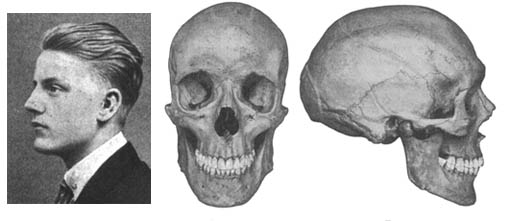
Nordic—The skull of a member of the Nordic white subrace, viewed from the front and the side. The “long” nature of the facial structure is clearly visible. Alongside is a classic Nordic male from Sweden.
Alpine—‘Solid’ Body, Round Head, Brown Eyes
The Alpine racial subgroup, which also still exists in a large measure today, is characterized by brown hair and eyes, a short, more “solid” body build and a distinctive “round” (that is, almost, but not quite, circular) skull shape.

Alpine—The skull of a member of the Alpine white subrace, viewed from the front and the side. The “shorter” facial structure is apparent. Alongside is a classic Alpine male from southern Germany.
Mediterranean—Mixture of Body Types
The original Mediterranean racial subgroup no longer exists today. It was the first of the three white racial subgroups to disappear from the earth, submerged into the gene pools of surrounding races.

Mediterranean—A skull of a member of the Mediterranean white subrace, viewed from the front and side. Alongside, a WWI Welsh soldier—as close an example of a Mediterranean as can be found in modern times.
The Mediterranean subgroup was predominantly (but not totally) characterized by dark hair and eye color, slim (Nordic), or solid (Alpine) build and either long or round skull shapes. It is worth stating again, as it is of great significance in more ways than one, that there are very few of these original Mediterranean racial types left in the world today. They were known as the “Old Europeans” and inhabited large parts of Europe, the Middle East, and Egypt at the dawn of history. These Mediterranean types bear almost no resemblance to the present day inhabitants of the Mediterranean basin.
The original Old Europeans have been absorbed almost completely into either the Nordic/Alpine stock in Europe, or the African/Semitic/Asian stock of North Africa, and the Middle East.
There are two places in Europe where occasional glimpses of this original Mediterranean racial subgroup can still be seen: the Celtic fringes of Britain (most notably in Wales and Devonshire) and in the Basque territory of Spain. In these regions there exists a short, dark strain—remnants of the original inhabitants of Europe.
Pure examples of this Mediterranean type are rare, as they have for the largest degree had some Nordic or Alpine admixture over the years. Unfortunately there has also been some admixture from North Africa. Nonetheless, it is still possible today to talk of “Mediterranean” whites even though they do not identically represent those of antiquity.
Other Subgroups—Dinarics and East Baltics
Two other white racial subgroups exist (Dinarics and East Baltics). These types differ slightly in skull shape and body dimensions from the three main groups outlined above, but they share a great number of physical characteristics such as hair and eye color.
As with the Alpines and Mediterraneans, there has been a great deal of mixing with the three main subgroups. They are found in large numbers in present day Eastern Europe. A very small percentage of these two subgroups also display the physical characteristics resulting from mixing with the waves of Asiatic invaders who penetrated Europe from the east during the course of history.
Whites Defined by Genetic Commonality
For the purposes of this book, an ethnic or cultural group is defined as part of the white race as long as it shares enough of a common genetic inheritance with the broader racial group. When an ethnic group loses this genetic commonality it is then formally excluded from the white racial category.
Tracking Race
How is race tracked in civilization? How is it determined whether the populations of certain societies or civilizations belonged to specific races? The answer to this is simple. Race in history is tracked in four ways: paleoserology, art forms, language, and the science of genetics. This last test has only come into its own in the last ten years of the twentieth century, but has proven to be a major aid in tracking racial history.
Paleoserology Reveals Racial Types
Paleoserology is the study of skeletal remains. As different racial groups have different physical characteristics, it is a relatively simple matter to determine the racial makeup of the inhabitants of a particular region by studying the contents of grave sites. This skill is often used by modern police pathologists to identify the race of corpses. This science has proven equally useful in historical diggings where the examination of burial sites has created an understanding of the racial makeup of ancient peoples.
Race Appears in Art Forms
Art forms (whether conventional pictures, illustrations on pottery, or even statues) also provide significant indicators of the racial makeup of contemporary inhabitants. The ancient civilizations in particular—of all racial group—reflected themselves in their art forms (often because their own racial types were the only human models from which they had to work).
In this way, for example, early Chinese art depicted principally Chinese people; Incan and Aztec art depicted only Incan or Aztec people, and so on. In all societies, original art forms which portrayed people closely followed contemporary physical appearances. This principle is well illustrated in the four art forms portrayed below.

Tracking race in history: race depicted in art forms. Early civilizations very often depicted images of their own racial types in their works of art, based on the reality that their own types were the most common (or only) human models with which they had to work. A comparison of (from left to right) Olmec art, 400 BC; African art, circa 1400 AD; Japanese art, 1000 AD; and Greek art, 340 BC, reflects this principle well. The study of art forms is a reliable indicator of the racial type of the communities in which the art works were created.
Genetics Reveals Racial Past
All human beings have three sorts of genes: mitochondrial DNA, which is inherited through the female line; Y-Chromosomes which are inherited through the male line, and autosomal DNA, which is inherited from both sexes. The study of genetics has served to confirm the accuracy of many historical accounts of racial movements, and is particularly useful in showing cause and effect in the rise and fall of civilizations, as demonstrated in this book.

Research carried out by L.L. Cavalli-Sforza and two colleagues, P. Menozziand A. Piazzia, in their work The History and Geography of Human Genes (1994), has revealed an astonishing 2,288 genetic point difference between whites and black Africans. The research found that the English differ from the Danes, Germans, and French by a mere 21–25 points of genetic distance, whereas they differ from North American Indians by 947 points, from black Africans by 2,288 points, and from MbutiPygmies by 2,373 points. Cavalli-Sforza also used Mitochondrial DNA (mtDNA—transferred through the maternal line) to divide the world up into seven distinct races, classifying whites as part of the “Caucasoid” group for his study.

Above: A map showing the pre-1500 AD Y-Chromosome distribution in the world, and below, a map showing the mtDNA chromosome distribution. Y-Chromosomes are male genetic markers, passed down unchanged through the male line, and mtDNA chromosomes are the female equivalent.

Language Reflects Racial Similarities
The study of language is another important clue to the dispersion of peoples. Commonalities in language forms leave clearly identifiable “fingerprints” in cultures. Similar words, phrases, or language forms are a clear indication of a single origin for civilizations, due to the fact that the people in those civilizations would at some stage have had a common origin. In this way the route of a culture (and hence a people) can be traced by following a language.
| English brother mother father | German bruder mutter vater | Greek bhrater meter pater | Old Persian brater matter pitar | Sanskrit bhrater matar pitar |
| Russian/Ukrainian (non-Cyrillic spelling.) Brat (pronounces as “Braht”) Mater (or just Maht with soft “t”) Batya (pronounces as “Bahtya”) |
An Objective Definition of Civilization
For the purposes of this book, civilization will be taken to mean the entire ambit of social/cultural manifestations which are characteristic to any particular nation or racial group. In this way the accusation of subjectivity can be avoided. Civilization, in the broadest sense of the word, includes all social manifestations, from social interactions to language, art forms, science, technology, customs, and culture.
It is therefore possible to talk of a Japanese civilization, an American Indian (Amerind) civilization, a Polynesian civilization, an Australian Aboriginal civilization, a black civilization and a white civilization, without being subjective about any of them.
The Question Posed by a “Rise and Fall”
When reviewing the historical development of all nations, quite often mention is made of a “rise and fall” of a particular civilization. This poses a major question: Why have some civilizations lasted a thousand years or more, while others rise and collapse within a few hundred? Why is it, for example, that nations such as Japan, Sweden, and England—all nations with limited natural resources—could have progressive active cultures for more than one thousand years; whereas mighty civilizations such as Classical Rome, Greece, or Persia, amongst others, collapse after only a few centuries?
Politically correct historians blame the rise and fall of the great nations of the past on politics, economics, morals, lawlessness, debt, environment, and a host of other superficial reasons.
However, Japan, England, and Sweden have gone through similar crises scores of times, without those countries falling into decay. It is obvious that there must be some other factor at work—something much more fundamental than just variations in politics, morals, lawlessness, or any of the other hundreds of reasons that historians have manufactured in their attempts to explain the collapse of civilizations.
Each Society Unique to Each People
Herein lies the key to understanding the rise and fall of all civilizations. In any given territory, the people making up the society in that territory create a culture which is unique to themselves.
A society or civilization is only a reflection of the population of that particular territory. For example, the Chinese civilization is a product of the Chinese people, and is a reflection of the makeup of the population living in China. The Chinese civilization is unique to the Chinese people; they made it and it reflects their values and norms.
As the Chinese people made the Chinese civilization, it logically follows that the Chinese culture would disappear if the Chinese people were to disappear. Presently the overwhelming majority of Chinese people live in China, creating the Chinese civilization in that land. If, however, Australian Aborigines had to immigrate into China in their millions, and the Chinese population had to dramatically reduce in number, then in a few years the character of Chinese civilization would change—to reflect the new inhabitants of that territory.
In other words, the society or civilization of that territory would then reflect the fact that the majority of inhabitants were now Aborigines rather than Chinese people. If China had to fill up with Aborigines, this would mean the end of Chinese civilization. Aborigines would create a new civilization which would reflect themselves, and not that of the Chinese people.
That this should happen is perfectly logical. It has nothing to do with which culture is more advanced, or any notions of superiority or inferiority. It is merely a reflection of the fact that a civilization is a product of the nature of the people making up the population in the territory.
A Theoretical Example: No Chinese People Means No Chinese Civilization
To go back to the Chinese example: If all Chinese people on earth had to disappear tomorrow, then fairly obviously, Chinese civilization and culture would disappear with them. It is this startlingly obvious principle which determines the creation and dissolution of civilizations—once the people who create a certain society or civilization disappear, then that society or civilization will disappear with them. If the vanished population is replaced by different peoples, then a new society or culture is created which reflects the culture and civilization of the new inhabitants of that region.
A Practical Example: Arrival of Whites Changed American Civilization
There are numerous examples of this process at work. One which will be familiar to all is the shift which occurred in North America. On that continent, the Amerind (American Indian) people lived for thousands of years, creating a civilization which dominated that continent. In other words, the civilization and culture which dominated North America reflected the fact that the Amerind people lived and formed the majority population there.
After 1500 AD that continent filled up with white immigrants from Europe. These white immigrants displaced the Amerinds by squeezing them out of possession of North America.
The great shift in North American civilization then occurred. Whereas the Amerind culture had dominated for thousands of years, within a couple hundred years the dominant civilization on that continent had become white European. This shift reflected the fact that the majority of inhabitants of North America were white Europeans—and the Amerind civilization, for all practical purposes, disappeared.
The Amerind civilization in North America “fell” because the population of North America changed.
Racial Shift Paramount
This effect—the displacement of peoples and the subsequent disappearance of their civilization—has direct implications in racial terms. The rise and fall of any particular civilization can be traced, not by the economics, politics, morals, etc., of a particular civilization, but rather by the actual racial presence of the people themselves.
If the society which has produced a particular civilization stays intact as a racially homogeneous unit, then that civilization remains active. If, however, the society within any particular given area changes its racial makeup—through invasion, immigration, or any decline in numbers—then the civilization which that society has produced will disappear with them, to be replaced by a new civilization reflecting the new inhabitants of that territory.

Egypt: Same country, different people. Above left: The white pharaoh, Queen Nefertiti, circa 1350 BC; Above center: The effects of racial mixing are clearly to be seen on the face of this coffin portrait of a Roman lady in Hawara, Egypt, 100 AD; Above right: The mixed race Egyptian, Anwar Sadat, president of Egypt in the twentieth century. Nefertiti ruled over an advanced civilization; Sadat ruled over a third world country. The reason for the difference in cultures between Nefertiti’s Egypt and Sadat’s Egypt was that the Egyptian people had changed.
Disappearance of Whites Led to the Collapse of Their Civilizations
Originally created by Proto-Nordics, Alpines, and Mediterraneans, and then influenced by waves of Indo-European invaders, the white civilizations in the Middle East all flourished, producing the wonders of the ancient world.
These regions were either invaded or otherwise occupied (through the use of laborers, immigration, or in rare cases, by conquest) by nonwhitenations of varying races. When the original white peoples who created those civilizations vanished or became an insignificant minority (through death and absorption into other races), their civilizations “fell” in exactly the same way that the Amerind civilization in North America “fell.”
500 BC—First Turning Point
It was around the year 500 BC that the first great turning point in white history was reached. This was the decline of the first great white civilizations in the Middle East and their subsequent replacement by nations and peoples of a substantially different racial makeup.
Up until this time the development of the white race’s territorial expansion was such that they were a majority in Europe and all of Russia west of the Urals. They formed a significant component of the population of the Middle East and their rule extended into the Indus River Valley in Northern India.
India—Origin of the Caste System
In India, for example, the Indo-Aryan population was diminished by four factors:
• A large nonwhite (Indian) immigration northward to do work offered by the society set up by the conquering Indo-Aryans;
• A high natural reproduction level amongst the nonwhiteimmigrants;
• The level of racial mixing amongst Aryans and the Indians, which, by creating a new mixed ethnic identity, also changed the racial makeup of the inhabitants of the region; and
• A decline in the birth rate amongst the Aryans.
In India, the invading Indo-Aryans established a strict segregation system to keep themselves separate from the local dark skinned native population. This system was so strict that it has lasted to this day and has become known as the caste system.
However, even the strictest segregation (and Aryan laws prescribing punishments such as death for miscegenation) did not prevent the majority population from eventually swallowing up the ruling Aryans until the situation has been reached today where only a very few high caste Brahmin Indians could still pass as Europeans.
Exactly the same thing happened in Central Asia, Egypt, Sumeria, and to a lesser degree, modern Turkey. Slowly but surely, as these civilizations relied more and more on others to do their work for them, or were physically conquered by other races, their population makeup became darker and darker.
Miscegenation with Nonwhite Slaves Caused Egyptian Decline
From the time of the Old Kingdom, the original white Egyptians had been using Nubians, blacks, and Semites (or Arabs) to work on many of their building projects or as general slaves.
At various stages the pharaohs also employed Nubian mercenaries, and ultimately Nubia and Sudan were physically occupied and incorporated into the Egyptian empire. Although the buildings of ancient Egypt are very impressive—many having survived through to the present day, their construction was dependent on the Egyptian ability to organize an unprecedented mass of human labor.
Under the direction of a scribe and architect, thousands of slaves and regiments of soldiers laboredfor decades to create the great buildings, using only levers, sleds, and massive ramps of earth. It is impossible to think that such massive use of slave and foreign labor would not have left some mark on the population of the land. Interbreeding took place, and this, combined with the natural growth and reproduction patterns of the slaves and laborers, meant that in a relatively short time they comprised a significant section of the population.
Several attempts were made to prevent large numbers of Nubians from settling in Egypt. One of the first recorded racial separation laws was inscribed on a stone on the banks of the southern Nile which forbade Nubians from proceeding north of that point. Nonetheless, the continuous use of Nubians for labor eventually led to the establishment of a large resident nonwhite population in Egypt, with their numbers being augmented by natural reproduction and continued immigration.
The region was also occupied for two hundred years by the Semitic Hyksos, who intermarried with the local population, and this was followed by other Semitic/Arabic immigration, fueled by the long existing black settlement on the southernmost reaches of the Nile River.
Once again the factors which led to the extinction of the Aryans in India came into play in Egypt: a resident nonwhite population to do the labor, a natural increase in nonwhite numbers, physical integration, and a decline in the original white birthrate.
All these factors compounded to produce an Egyptian population makeup of today that is very different from the men and women who founded Egypt and designed the pyramids.
As the population makeup shifted, so the cultural manifestations, or civilization, of that region changed to the point where the present day population of the Middle East is not by any stretch of the imagination classifiable as white. This explains why the present inhabitants of Egypt are not the same people who designed the pyramids.
The Egyptians of today are a completely different people, racially and culturally, living amongst the ruins of another race’s civilization.
Identical Reasons for Decline in Middle East
The decline and eventual extinction of the white population in the Middle East marked the end of the original civilizations in those regions. In all the Middle Eastern countries the Semitic (Arabic) and black populations grew as they were used as laborby the ruling whites. In the case of Sumer, the white rulers were physically displaced by military conquest at the hands of Semitic invaders.
This process continued until almost all remains of the original whites in the greater region were assimilated into the darker populations. Only the occasional appearance of light colored hair or eyes amongst today’s Iraqis, Iranians, Syrians, and Palestinians serve as reminders of the original rulers of these territories.
Lesson—Role of Racially Foreign Labor in the Decline of a Civilization
The lesson is clear: a civilization will remain intact as long as its creating race remains in existence. This applies to all races equally—white, black, Mongolian or any other. As long as a civilization’s founding race maintains its territorial integrity and does not use large numbers of any other alien race to do its labor, that civilization will remain in existence.
If a civilization allows large numbers of racial aliens into its midst (most often as laborers) and then integrates with those newcomers, that civilization will change to reflect the new racial makeup of the population.
Any civilization—be it white, black, Asian, or Aboriginal—stands or falls by the homogeneity of its population, and nothing else. As soon as a society loses its homogeneity, the nature of that society changes. This simple fact, often ignored by historians, provides the key to understanding the rise and fall of all civilizations, irrespective of race.

Evidence of black slaves in Egyptian and Grecian society. Left: Nubian (African) slaves as depicted in ancient Egyptian art, and right two Greek vases, dating from the fifth century BC, show the racial types of two slaves, a Semite and a black.
History Is a Function of Race
The early white civilizations in Greece and Rome also fell to this process. The last great Grecian leader, Pericles, actually enacted a law in the year 451 BC limiting citizenship of the state according to racial descent. However, some four hundred years later this law was changed as the population shifts had become more and more evident. Certain Roman leaders tried to turn back the racial clock, but their efforts were in vain.
The sheer vastness of the Roman Empire meant that all sorts of races were included in its borders, and this brew ultimately led to the dissolution of the original Roman population.
Those who occupy a territory determine the nature of the society in that territory. This is an immutable law of nature. It is the iron rule upon which all of human endeavour is built—that history is a function of race.
The Rise and Fall of Civilizations Explained
• Each and every society and culture is the sum and unique product of the people making up that society;
• For example: The Chinese civilization is the product of the Chinese people, the Australian Aboriginal culture is the product of the Aboriginal people, and white society is the product of white people;
• This has nothing to do with subjective notions of superiority or inferiority;
• If the people in a society change their racial makeup, it is therefore logical that the culture of that society will change to reflect this shift in society;
• This is what is called the “rise and fall” of civilizations—where one culture gets replaced by a different culture;
• The cause of this replacement of cultures is the replacement of the people in that society;
• In this way, the American Indian culture “fell” because they were replaced by whites as the dominant race on the North American continent;
• Civilizations do not then “fall”—they are merely replaced by another culture, which is the product of the new population;
A civilization “rises and falls” by its racial homogeneity and nothing else. As long as it maintains its racial homogeneity, it will last—if it loses its racial homogeneity, and changes its racial makeup, it will “fall” or be replaced by a new culture.
This is a chapter from March of the Titans, The Complete History of the White Race, available here.


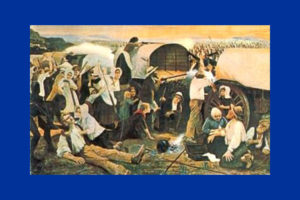
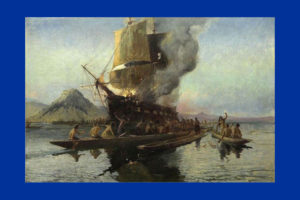
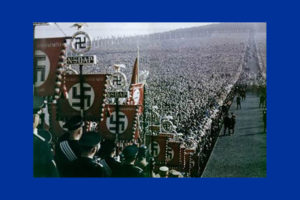
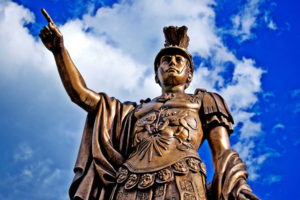
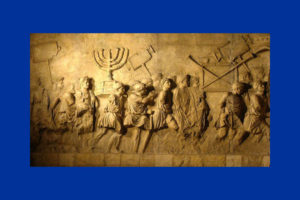
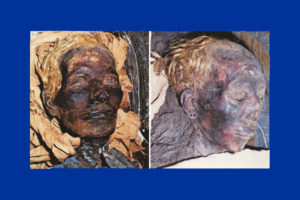
out of africa theory is a lie
an eye opener!
where i can i buy the march of titans in texas ? ….thanks, dj
http://ostarapublications.com or Amazon.com-Ed.
I am a Social Scientist. Does anybody feel that the Migrant Worker and the illegal Immigrant in the UK could wipe out the white race here? I would love to hear your thoughts. Also is March of the Titans available as Audio Book as I would love to buy this for my Grandparents as they are loosing their eyesight. Many Thanks.